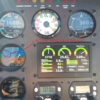In my experience winds aloft forecasts in the western Colorado mountains are not very accurate, and I question them everywhere as a result.
I flew over the elk range one day from KEGE to KGUC, winds aloft was predicting 50kts at 15,000 from the west south west, I flew by Capitol Peak at 14,500 on a magic carpet. Smooth as glass ride and no perceptible crabbing due to crosswind. I'd estimate that the wind at 14,500 was 10kts or less. Last fall I went out to do some stalls to see what my ground speed was vs indicated airspeed. Winds aloft reported 2kts at 9000 and 3kts at 12000, I was at 10,000. Airspeed indication going southwest at 40mph gave a ground speed of around 40mph, I turned around and went the other way, 40 indicated was mid 60's ground speed. Clearly not 2kts! I have seen this many times.
Over Nebraska a couple years back, I was at 10,500. I checked the winds aloft forecast on ForeFlight, it indicated that I would have a 10kt advantage at 12,000. So, I climbed to 12,500. My ground speed was actually slightly less up there.


